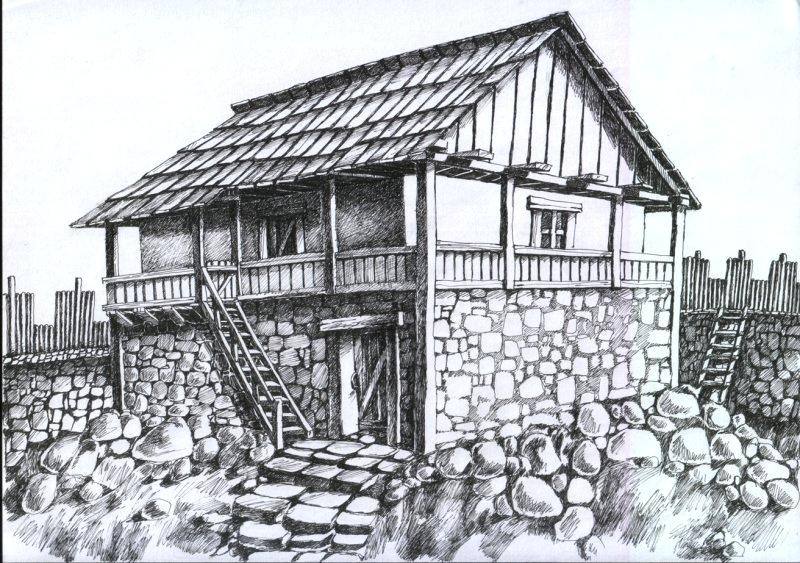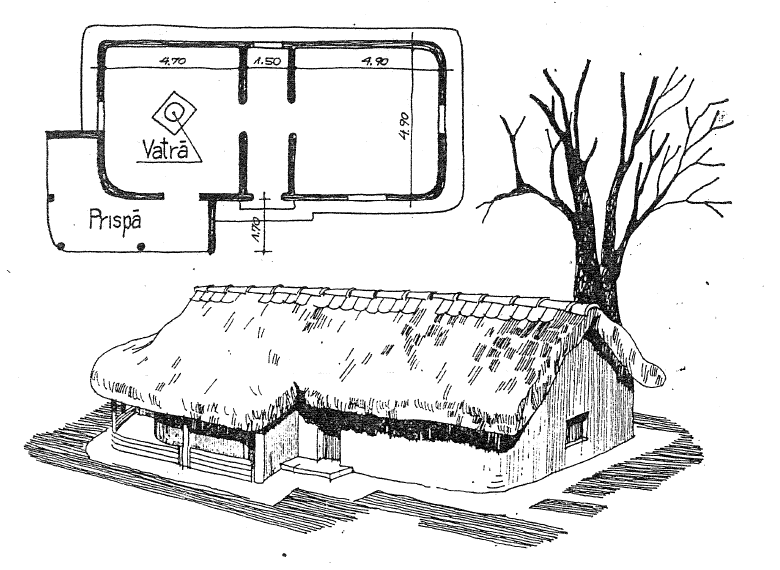Bagnot, Dunstop, and Alda-Chur were all settled by South Pelorian refugees within a generation of Arim the Pauper entering Dragon Pass. Bagnot and Dunstop were settled around 1340 ST by different groups of settlers. Bagnot by Arim the Pauper and his followers, and Dunstop by a group that called themselves the Danbalings.
Bagnot
Bagnot was established as a religious and political center around a central temple complex to Ernalda and Orlanth. About 25 km from the Shaker’s Temple and about 45 km from Kero Fin Mountain, it guarded the entrance to the sacred valley. It was settled by refugees from Southern Peloria, from what is now Holay and Aggar. At its height (1370-1490), the city had a population of some 7,500 to 10,000 people and covered 75 hectares (about the size of Roman Lughdunum or Pompei). That’s about 900 meters on a side, or about 3.6 km of wall (2.25 miles).
Bagnot was the residence of the Twins Dynasty and of the Illaro Dynasty until the founding of Furthest in 1492. During that time it was the most important city in Dragon Pass and in Southern Peloria. From 1490 to 1582, Bagnot was the capital of the Tarsh Exiles and allied with the Kingdom of Sartar, who provided masons to improve the walls. During this time the city declined in importance and population.
Bagnot fell to the Lunar Army in 1582. The city was badly damaged and the temple to Orlanth Rex was destroyed, its gold and bronze doors taken by King Moirades (and later given to the Feathered Horse Queen) and a temple to the Seven Mothers built in its place. The temples to Ernalda and Orlanth Thunderous remained (although the Thunderous temple was dedicated to Barntar). The other Lightbringers shrines were rebuilt with largess from Furthest.
Dunstop
This city on Kordros Island was founded by the Danbalings around 1340 and is considered the agricultural center of Tarsh. Dunstop rebelled against Hon-eel in 1490 and was loyal to the Tarsh Exiles until 1582 when it was given by King Moirades to Vostor Blacktooth and his Orindori Clan, who have ruled it since. The Orindori have been generous patrons to the city, rebuilding damaged buildings
It is built on a low hill surrounded by flat agricultural land of barley and maize. With a population of around 5,000 people, it is the second largest city in Tarsh after Furthest. Dunstop has three rings of walls around a central citadel and surrounds an enclosed area of some 50 hectares.
The most notable structures atop the citadel are the palace of the royal deputy (Orindori Palace) and the major temple to the Seven Mothers. Other temples, civic buildings, and noble residences surround the citadel. The most important temple is the great temple to Ernalda and the Grain Goddesses.
See also
Alda-Chur
Alda-Chur was founded around 1351 in the wake of the Lunar Daughter’s Road Campaign by settlers from Saird, a large minority of whom belonged to the Yelmalio cult. However, the Orlanth cult was too powerful for a Sun Dome temple to be built (which requires that the Yelmalio cult is the ruling cult), but a Sun Temple was built. The city was a stronghold against Chaos and Darkness, and was friendly with the Orlanthi tribes to the south.
After 1490, Alda-Chur became an independent city-state closely allied with the new Kingdom of Sartar. The city became a key waystation for caravans traveling between Sartar and the Lunar Empire, and the city built strong walls with the aid of Sartar. It covered about 40 hectares for a normal population of about 4,000. In 1583, Alda-Chur joined the Kingdom of Sartar and built a temple to Orlanth Rex.
The city fell to the Lunar Empire in 1602, it became an important garrison city for the Lunar Army in Dragon Pass. With Lunar support, the leader of the Yelmalio cult, Harvar Ironfist, made himself ruler of the city. The temple to Orlanth Rex was closed, and a temple to the Seven Mothers constructed. Barracks were constructed outside of the city to house some of the soldiers garrisoned there, although many soldiers were billeted in civilian homes. For nearly a decade, the city had as many soldiers as civilians, bringing the total population to some 8.000. The city has numerous inns and caravanserai, and is the most densely populated in Dragon Pass.
See also
![]()
![]()
One thing about all three cities – they were established initially as villages around a temple or shrine and quickly grew. Bagnot grew fastest, probably went from 100 to 2000 in a generation (and was 7000+ within another generation or two). So they all have a central temple area, a market/assembly square, but then buildings and streets just went out from there. In all cases, walls were built fairly early and so at times the cities were pretty densely settled (although now Bagnot is likely pretty empty).
Obviously Dunstop and Alda-Chur grew more slowly. Then again, they did not decline during the post-1490 era, and Alda-Chur even grew.
But they are all took shape about 200-250 years ago. They are older than Sartarite cities and no doubt look it. The buildings are made of clay, stone, and wood. Many older buildings were made by Lunar crafters who were employed or taken prisoner or whatever during the period of Tarsh’s first kingdom (which happened to be when Sheng Seleris and his nomads were overrunning Peloria).



It’s very interesting to see that the Exiles had Orlanth Rex. Yes, Orlanth Rex comes from Tarsh to Sartar after all. Orlanth Rex was not present in Kethaela. Sartar introduced the cult. Remember that the cult of Orlanth Rex was discovered by Alakoring Rex. And the magic in that cult (especially Command Priest) turns out to have be critical in Alakoring’s war against the EWF. But Alakoring never got south of Dragon Pass, and the Hendriking never had that magic.
